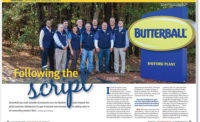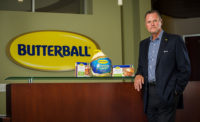In mid-November, Andy Hanacek, editor-in-chief, visited Raeford, N.C., in order to attend the ribbon-cutting ceremony and get an exclusive tour of the new Butterball further-processing plant there (which was also still under construction at presstime). President and CEO Kerry Doughty covered some of the background on how Butterball came about purchasing and planning for the facility in the corporate portion of this cover story package, and what follows is a portion of the conversation Hanacek had with Mike Bliss, vice president of Operations for Butterball, and Frank Koekkoek Jr., complex manager in Raeford, tackling some of the finer points of the renovation, startup and expectations for the facility:
Additional Butterball content
Check out our January 2016 cover story, "Butterball: The house wins," and our exclusive videos from the ribbon-cutting ceremony of Butterball's Raeford, N.C., plant.
Hanacek: Starting from a general view, what positive attributes attracted Butterball to the Raeford plant when it came on the market?
Bliss: The value is its location first and foremost — that it is only two or three hours from here to the Mount Olive facility — so our ability to get raw materials here for processing was a positive. Also, it’s a plant that had previously been involved in further-process value-added production, so we knew we would have a workforce that was mostly trained. Then when we saw the facility, it laid out nicely, with a straight flow-through design, so it presented an opportunity with renovations to become a very nice further-process value-added facility for us. … There was a workforce in place that was mostly trained already in GMPs and SOPs and what it means to work in a food-processing facility. Everything was right for us to be able to do something and do something quickly.
Hanacek: Talk about the turnaround time from due diligence in fall of 2014, to purchase at the beginning of 2015 to starting up first production lines in May 2015. That’s a quick process — what contributed most to that turnaround time?
Koekkoek Jr.: It took a lot of involvement with Larry Enders, who was the engineering lead over the project, and a maintenance manager from Mount Olive, Scott Holt, who’s instrumental in where Raeford is today. It took a lot of planning and making sure that we adhered to the budgets, [figured out details] that we weren’t really familiar with, like resealing parking lots, for example, all the way down to the color of the floors of the break rooms, how we should lay the break rooms out, how we would paint the break rooms.
Bliss: Another big plus that Frank mentions is that, because the plants are so close, we were able to send as many resources as we needed from Mount Olive to the Raeford plant to support every aspect of developing or recreating the business here, whether it was quality assurance, IT, HR, accounting, engineering, maintenance.
Hanacek: How big is the plant and how many employees do you expect to have here?
Koekkoek Jr.: Raeford is 243,000 square feet overall, and the total workforce as it stands [at presstime in November] is 220 associates. In 2016, as we add additional processes including an evening shift for further processing, we’re adding an additional 277 hourly associates. … So by the end of 2016, the total would be 497 associates. We almost double in workforce size.
Hanacek: You mentioned earlier that finding and hiring a qualified workforce here hasn’t been too difficult, given that the plant was a turkey-processing facility under House of Raeford and it was shut down for only a short time. What type of reception did the new workforce give Butterball and how did you try to transition them into the company?
Koekkoek Jr.: We acquired the facility Feb. 19, 2015. Between the time of the announcement, which was on a Thursday, and the following Monday, we had around 350 applicants that were standing outside waiting for applications to get back to work. I felt that it was very important for me to be involved with the first four to five orientations, to set expectations for all associates to understand our vision. … There was a high level of concern around how committed Butterball was, how long would we actually be here now that we bought the facility. I made orientation more family oriented, and we had more face-to-face introductions. The message is, we’re a business where we want to be team members, hand-in-hand. We want our associates to be our business partners as well.
Hanacek: After you did all the due diligence on the facility and had purchased it, how quickly did you determine what Raeford’s focus and product mix would be? Were there any surprises that forced you to shift gears in that plan?
Bliss: Well, the plant was in need of a facelift, not only in the raw side of the business but on the ready-to-eat side, and it didn’t take us much time to decide [what] was needed in ready-to-eat. We’d be taking all floors out, all drains, all walls — and we’d basically demo the entire ready-to-eat portion of the plant and starting over — so that it would meet Butterball’s standards from the dirt up. … All we kept was the outer shell of the building. Additionally, we tore out all the existing ovens — a continuous oven and six batch ovens. All of that equipment was scrapped because, from a ready-to-eat perspective and what it means to protect our Butterball brand, it just wasn’t worth risking.
To be honest with you, I don’t know of a wall or a floor or a light or a door that hasn’t either been replaced, taken down, taken apart, cleaned, painted, reconditioned or steam-cleaned. Basically, it’s the closest thing to starting off with a new plant as you can get without building on a field. … Our original investment was right at $45 million, but when we made our decision to bring our slicing operations here, that added another $10 million. So our initial investment including the renovation of ready-to-eat will put us right about $55 million.
Hanacek: Let’s discuss the plant for the ready-to-eat side, which is still under construction. Describe for me the plan for that giant part of the plant — what should I expect to see in that room the next time I visit?
Bliss: Of course, our investment will bring it up to best-in-industry standards. We’re starting off with two new ovens, and we have a space already reserved for the third oven, which we’ll probably add in 2017. There’s also room to add two more, for a total of five batch ovens, at some point in time. So the RTE part of the plant will start off with four rooms that we’re setting up to slice in. We’ll equip three of those rooms to start and support the two ovens, and later we hope to add equipment to the fourth room.
Hanacek: You mentioned moving the slicing operations here, and while we were on the tour, that came up as a big benefit of renovating this large RTE space in Raeford. Where is the slicing operation centered now, and what will moving it to Raeford allow Butterball to do?
Bliss: Part of the decision to move slicing to the Raeford plant was based on the need to increase slicing capacity of a particular type of product at Mount Olive. The 15 million pounds of sliced business that we’re moving here already is being replaced in Mount Olive by 15 million pounds of another type of a sliced product. So we’ll still be slicing in Mount Olive, it will just be different product. Actually, the type of product that we’ll do at Mount Olive [is twice as large] on a capacity-per-line basis. … We’ll actually slice more volume in total as a company when it’s all said and done. Also, by changing the mix between Mount Olive and Raeford, Mount Olive [will be more efficient with] smaller turkey breast pieces — less than three pounds. In the past, we put them on racks and into batch ovens at about 12,000 pounds per oven cycle. With the changes we’re making at Mount Olive, we’ll have an inline cook-chill system which will no longer require racking, so we’ll gain another 11 million pounds of cook capacity there without adding any additional ovens, just by shifting that mix.
Hanacek: What were the challenges to the entire Raeford process that maybe you didn’t expect and how did you get over those hurdles? I know it was a pretty smooth, quick transition, but it couldn’t have been perfect.
Koekkoek Jr.: As surprises occurred, we weren’t caught too far off-guard, because Scott Holt, Larry Enders, Steve Valesko, Mike and I had daily calls [during the project]. There were surprises that occurred. The FRP paneling in the tray-pack room wasn’t in great shape, so we quickly made the decision to properly remove the FRP boarding, bond the walls, buff them down and make sure that it was acceptable from a food-safety standpoint, again to protect the Butterball brand and our consumers.
Bliss: For the level of work that was done with the building — remodeling, renovation, demolition — there were very few surprises. … We ended up replacing some roofing in the distribution dock and the receiving dock, which we hadn’t anticipated.
Fortunately, having the support we had from the senior leadership group in Garner, we were able to make quick decisions and go. We didn’t have to go through a lot of lengthy approval processes. But beyond the building itself, what else did we go through? On product, Frank, you’ve been in production six months and you’re upward probably 17, 18 million pounds. How many customer complaints have you had?
Koekkoek Jr.: We’ve had very few complaints.
Bliss: Which is amazing for a startup. We’ve been operating six months, and from a quality, food safety and USDA perspective, all has gone very well. Frank, on labor, if you needed a hundred people, were you able to get a hundred people?
Koekkoek Jr.: Yes, hiring has not been a factor at this point.
Bliss: However, let’s talk about something that we never would have thought of being a problem. One of the reasons we acquired this facility is its location in relation to Mount Olive and our raw-materials stream. We thought, “Mount Olive’s right there, killing 60,000 turkeys a day, so they’ve got turkey meat all ready to go, so it’ll be no problem. We’ll just call, order, put it on a truck and have it here.” Well, that’s been a struggle, the scheduling piece with Mount Olive. Mount Olive has this raw-material stream close, but everybody is trying to get their share of that pile every day. The pile of turkey meat is supplying the Mount Olive plant, customers of Mount Olive, co-packers, and now Raeford. What we thought was going to be a no-brainer has really turned out to be quite a challenge that we’re still working through. NP










Report Abusive Comment